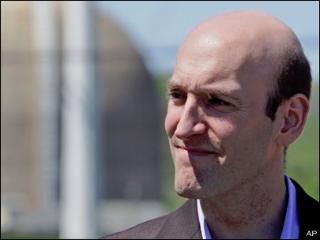
Publisher:
Bonnie King
CONTACT:
Newsroom@Salem-news.com
Advertising:
Adsales@Salem-news.com

~Truth~
~Justice~
~Peace~
TJP
Jun-22-2011 21:17

 TweetFollow @OregonNews
TweetFollow @OregonNews
Remarks of NRC Chairman Gregory Jaczko
Salem-News.comStatement made during the IAEA Ministerial Conference Monday.
 Gregory Jaczko KCBY in San Luis Obispo |
(VIENNA ) - I want to spend a moment recapping for you what the United States is doing and then look forward a bit.
The NRC is a little more than two-thirds of the way through a 90-day review of the Fukushima accident to see if there are issues to address in the short term. The report of that work should be out in about three weeks and our commission will meet on July 19 to hear the staff recommendations.
While it is my opinion that U.S. nuclear plants are safe, the early work suggests there are a number of possible areas for improvement. To name a few, several of us on the commission have noted that our regulations for what is called a station blackout – essentially what happened in Fukushima – do not take into account an extended loss of AC power. Other areas that have drawn attention are spent fuel pools, emergency planning, of course seismic issues, contingency planning for situations beyond the design basis of a plant, and others.
The NRC has also run some preliminary inspections on areas like coping with unanticipated disasters, station blackout preparations, and severe accident mitigation. Again, while I see nothing that calls into question the safety of our plants, I see areas where performance was not as good as would be preferred.
I believe there is a likelihood that the agency will need to make some changes, although it is too early to say right now precisely what those changes might be.
On the global front – and this is a truly global issue – the real question is where to go from here?
This conference is building on the work started here in April and continued last month in Paris at the G-20 and NEA.
Let me offer a few thoughts about how I think the issue can be approached.
The meeting discussions indicate that each regulator is ensuring that appropriate actions are taken in the near term to improve public safety. This issue is going to linger and the approach that should be taken is methodical, taking lessons over both the short and long term. National efforts should be developed with the maximum possible transparency in mind. For example, in the United States, our work is public. Inspection results are being made public, as usual. And our initial report will be public.
In addition, I believe there are multiple ways to approach safety assessments and implement the lessons learned. Each nation can learn from others. Each nation’s path forward will depend on national and international circumstances. In the United States our agency is doing sampling inspections to compare the existing plant conditions with the regulatory requirements and industry commitments, as well as taking a very introspective look at our regulatory system.
And the industry in the United States is taking its own steps. Listening in one of the working sessions yesterday, I heard something similar from others. Clearly, safety can be strengthened by sharing feedback among nations as we are doing here this week.
I also believe that the IAEA is very well positioned to develop international best practices – a center for global coordination if you will – and those best practices can help strengthen the international nuclear safety effort. Finally, I would say that the work being done here this week will provide a firm underpinning for the further development of improved nuclear safety at the General Conference in September.
NRC News release
U.S. NUCLEAR REGULATORY COMMISSION
Office of Public Affairs Telephone: 301/415-8200
Washington, D.C. 20555-0001
E-mail: opa.resource@nrc.gov
Site: www.nrc.gov
Blog: http://public-blog.nrc-gateway.gov
Articles for June 21, 2011 | Articles for June 22, 2011 | Articles for June 23, 2011
Quick Links
DINING
Willamette UniversityGoudy Commons Cafe
Dine on the Queen
Willamette Queen Sternwheeler
MUST SEE SALEM
Oregon Capitol ToursCapitol History Gateway
Willamette River Ride
Willamette Queen Sternwheeler
Historic Home Tours:
Deepwood Museum
The Bush House
Gaiety Hollow Garden
AUCTIONS - APPRAISALS
Auction Masters & AppraisalsCONSTRUCTION SERVICES
Roofing and ContractingSheridan, Ore.
ONLINE SHOPPING
Special Occasion DressesAdvertise with Salem-News
Contact:AdSales@Salem-News.com

googlec507860f6901db00.html



Terms of Service | Privacy Policy
All comments and messages are approved by people and self promotional links or unacceptable comments are denied.
COLLI June 23, 2011 6:54 am (Pacific time)
While we may not be poised for a nuclear meltdown, I must disagree about how safe our plants are. With 48 of 65 sites leaking Tritium from underground pipes, I would not consider even hinting that U.S. nuclear plants are safe. Cesium-137 and Strontium-90 have also been discovered in some of these leaks. While our government has known about these leaks since the 1990's it was only in 2005 that this information was made available to us. During that time, over 6 million gallons of tritium-laden water was leaked by the nuclear power plant in Braidwood, Illinois alone. How much has reached the groundwater and aquifers? Safe? Not in a pig's eye are they safe! Yet, our government continues to renew the licenses to operate these same plants leaking a glowing death into our waterways. No, we will not die a quick death from a nuclear meltdown . . . it will be a slow and agonizing death from the cancer caused by ingesting water laden with invisible radioactive particulates.
[Return to Top]©2025 Salem-News.com. All opinions expressed in this article are those of the author and do not necessarily reflect those of Salem-News.com.